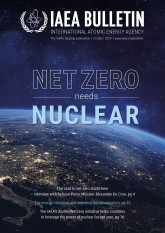
If you would like to learn more about the IAEA’s work, sign up for our weekly updates containing our most important news, multimedia and more.
What the Nuclear Declaration at COP28 Means for IAEA Verification
Eva Morela Lam Redondo

The ‘Declaration to Triple Nuclear Energy’ reflects a collective commitment to advancing nuclear energy as part of a sustainable and low-carbon future. This aspirational goal will also entail an increase in the nuclear material and facilities subject to IAEA safeguards. (Photo: IAEA)
On 2 December 2023, during the 28th annual Conference of the Parties to the United Nations Framework Convention on Climate Change (COP28), representatives from more than 20 countries came together to sign the ‘Declaration to Triple Nuclear Energy’ aiming to reach that target by 2050. As the world is eager to harness the benefits of nuclear energy, tripling nuclear capacity globally will also contribute to another global trend: the steadily growing volumes of nuclear material and numbers of facilities subject to IAEA nuclear verification.
The IAEA fulfils its nuclear verification mission through the application of technical measures commonly referred to as nuclear ‘safeguards’. These measures allow the IAEA to independently verify that States comply with their international obligations to use nuclear material solely for peaceful purposes.
“Between 2010 and 2022, we saw a 34% increase in the amount of nuclear material, and a 15% increase in the number of nuclear facilities and locations outside of facilities, under IAEA safeguards”, said Massimo Aparo, IAEA Deputy Director General and Head of the Department of Safeguards. “The Declaration to Triple Nuclear Energy will further accelerate these trends. While the IAEA is ready to meet this challenge and continue to draw conclusions on the peaceful use of nuclear material, this will require sustained interaction and cooperation with all stakeholders and the adoption of innovative verification technologies.”
To meet the increase in demand for its services, the IAEA’s Department of Safeguards continually seeks to increase the effectiveness and efficiency of IAEA safeguards. Furthermore, the IAEA is legally obliged under comprehensive safeguards agreements to take full account of technological developments in the field of safeguards. Such examples of recent technological advancements include exploring and leveraging artificial intelligence and robotics in nuclear verification processes.
To keep abreast of new technologies with promising potential applications for safeguards, the IAEA works with its Member State Support Programmes (MSSPs). MSSPs extend support to the IAEA in various forms, including via R&D, knowledge exchange, technology transfer, expert collaboration and financial support.
The Next Generation Cherenkov Viewing Device (XCVD) represents a notable, tangible outcome of the IAEA’s development of safeguards instrumentation combined with MSSP facilitation and support of in-field testing. The XCVD substantially improves the verification efficiency and data quality of images taken by IAEA safeguards inspectors to verify the presence and integrity of nuclear material in spent fuel ponds. In 2023, the XCVD was used for the largest spent fuel verification campaign in the history of IAEA. It demonstrated an eight-fold increase in efficiency in the successful verification of spent nuclear fuel compared to previous methods.
Safeguards implementation is a collaborative effort between the IAEA and States. To this end, the IAEA also supports States in building the knowledge and capacity of their national authority responsible for safeguards implementation (SRA) and of their respective system of accounting for and control of nuclear material (SSAC). The IAEA does this through a variety of assistance mechanisms, including advisory service missions, training courses, e-learning and webinars, legal and regulatory assistance and the safeguards traineeship programme. One significant development in the field of safeguards assistance for States is the integration of COMPASS, the IAEA’s Comprehensive Capacity-Building Initiative for SSACs and SRAs, into the suite of IAEA safeguards assistance for States. Launched in 2020, and supported both financially and in-kind by IAEA Member States, COMPASS partners with States to help them strengthen the effectiveness of their SRA and SSAC. By offering State-specific support in the areas of stakeholder outreach, national training, software, legal and regulation and human resources, COMPASS represents a multi-year effort to sustainably build and enhance State capacity.
“The COMPASS initiative has been a game changer for Malaysia. It really helped us to identify the gaps in safeguards implementation”, said Nurul Hafiza binti Mohamed Aliasrudin, Assistant Director, Nuclear Installation Division, Department of Atomic Energy, Malaysia. “In two years, COMPASS helped us review safeguards regulations, develop technical guidelines and license conditions, and also enhance the training within the national safeguards authority.”
The IAEA is also looking to the future and, through Safeguards by Design (SBD), provides guidance to State authorities, designers, equipment providers and prospective purchasers on the importance of taking international safeguards into account when designing a nuclear facility or process. A voluntary best practice, SBD allows for informed design choices that optimize economic, operational, safety and security factors, while taking into account international safeguards. It is applicable to all aspects of the nuclear fuel cycle, from initial planning and design through construction, operation, waste management and decommissioning. For new nuclear facilities, especially novel designs or processes, the earlier the discussions of safeguards occur the better. SBD allows for safeguards to be ‘built into’ the design rather than around it.
The ‘Declaration to Triple Nuclear Energy’ reflects a collective commitment to advancing nuclear energy as part of a sustainable and low-carbon future. This aspirational goal will also entail an increase in the nuclear material and facilities subject to IAEA safeguards. By utilizing advanced technologies and working cooperatively both with those States looking to expand their nuclear energy production and those just starting out, IAEA safeguards stand ready to meet the increased demands of the international community as the world looks to achieve net zero.

